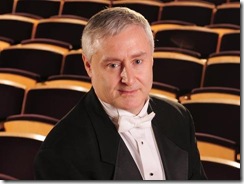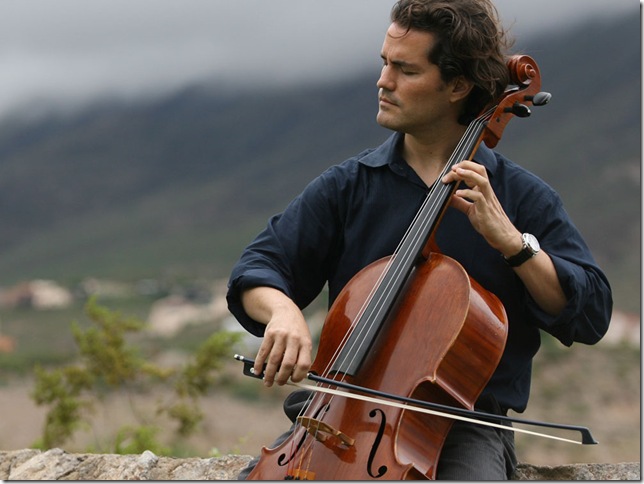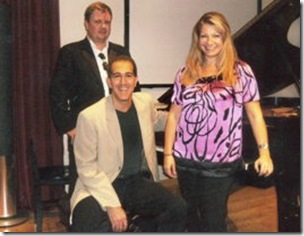South Florida Symphony Orchestra (Nov. 15, Crest Theatre, Delray Beach)
One of Sergei Prokofiev’s last works was his Sinfonia Concertante (Op. 125), a reworking of his earlier Cello Concerto and one of the most challenging such pieces in the repertoire.
The American cellist Zuill Bailey, a repeat guest with the South Florida Symphony, returned to that ensemble’s season-opening concert series Nov. 15 with a performance of this work at the Crest Theatre in Delray Beach. Conductor Sebrina Maria Alfonso, suffering from a wrist injury, was replaced for the orchestra’s first series of concerts by Piotr Gajewski, director of suburban Washington, D.C.’s National Philharmonic (and a former member of the Rockville, Md., City Council).
Bailey is a cellist of great energy and thorough technical accomplishment, which was absolutely necessary for the three movements of a technically treacherous concerto that put Bailey in close contact with the upper reaches of his A-string much of the night. It is also a work of savage beauty, a tapestry of dark themes, intense emotion and widely varied orchestral color (the orchestration was actually completed by another composer filling in for the ailing Prokofiev, who died a year after its premiere).
An ability to bring off the blizzard of notes that opens a passage such as the opening bars of the second movement is not, of course, enough, but fortunately Bailey also possesses an exciting singing tone that carried the concerto’s more lyrical moments thrillingly forward. The beginning of the third movement was another good case in point, with Bailey bringing a big, broad tone to the chief theme that established it with memorable shape and style.
 Gajewski led the orchestra with skill and care in accompanying Bailey, who played this music with the mix of astringency, quirkiness and warmth that distinguishes the work of Prokofiev from most other composers. This is the only live performance of the Prokofiev that I can remember being available on local concert stages in years, and it received a powerful reading. I’d bet Bailey’s interpretation of the Shostakovich First Concerto, which was inspired by this piece, is every bit as good. Perhaps on his next visit he can add a recital program to his South Florida sojourn.
Gajewski led the orchestra with skill and care in accompanying Bailey, who played this music with the mix of astringency, quirkiness and warmth that distinguishes the work of Prokofiev from most other composers. This is the only live performance of the Prokofiev that I can remember being available on local concert stages in years, and it received a powerful reading. I’d bet Bailey’s interpretation of the Shostakovich First Concerto, which was inspired by this piece, is every bit as good. Perhaps on his next visit he can add a recital program to his South Florida sojourn.
The other major work on the program was the Symphony No. 4 (in F minor, Op. 36) of Tchaikovsky, an orchestral showpiece that never fails to win audience approval. The symphony got off to a weak start with brass glitches, but settled in with strong string playing and good tempos. The second movement featured fine work from the solo oboist and a particularly nice first entrance by the cellos.
The third movement, a tour de force of clever orchestration, was less satisfying; Gajewski’s tempo was oddly slow, and the strings played their pizzicatos with little accent, which made the music sound bland and directionless. The brasses came in clumsily, which also hurt the effect of this section-by-section showcase. The finale was much better, with conductor and orchestra giving it their all in a tempestuous, aggressive traversal of this symphony that drew shouts of acclaim from the modest house at the Crest.
The concert opened with good Verdi, in the person of the overture to his opera Nabucco, with no-nonsense tempi from Gajewski that moved the music along with the youthful muscularity so central to Verdi’s early style.
The South Florida Symphony inaugurates its first pops season Dec. 2-7 with four performances in Monroe, Broward and Palm Beach counties. Its Dec. 7 performance is set for 8 p.m. at the Kaye Auditorium on the campus of Florida Atlantic University in Boca Raton, and features tenor Davron Monroe and pianist Thomas Pandolfi in music by Copland, Gershwin, Bernstein, Mitch Leigh, Marvin Hamlisch, Andrew Lloyd Webber and Frank Wildhorn. Call 561-297-6124 for tickets or visit www.southfloridasymphony.org.
***
Cameo Chamber Players (Nov. 9, Steinway Gallery, Boca Raton)
There were very few people at a Steinway Gallery concert Nov. 9 of Robert Prester’s Cameo Chamber Players, but those who weren’t there missed out on some fine music.
The piano trio of Prester, violinist Dina Kostic and cellist Christopher Glansdorp played two important trios, the No. 44 (in E, Hob. XV: 28) of Franz Joseph Haydn, and the Trio No. 1 (in B, Op. 8), of Johannes Brahms.
Both performances were eminently respectable, and offered a chance to hear some good repertory that doesn’t come around that often hereabouts. There was a basic balance problem in the room in that Prester’s piano tended to drown out Kostic and Glansdorp; if the Cameo group returns to the hall, a short-stick approach might be better.
Still, there was a fine rapport between the three players, evident from the opening of the Haydn. This trio, written in 1797, offers us some of Haydn’s most endearing trademark wit, with a surprising main theme in the first movement with one phrase that you could almost call bluesy, and a minor-key walking bass throughout the second movement that adds a ribbon of beautiful color under the rest of the music.
Much of the focus of the two trios was on Prester, who has virtuoso-style material to handle, and in both he had clearly worked hard to do so (he could have used a page-turner, too). His playing was technically adept, with impressive washes of notes in the Haydn, but he needed to hold back when playing an instrument that powerful against two lone string instruments. His playing also needed more variety and subtlety; it came off sometimes as heavy and effortful.
Kostic and Glansdorp , veteran players who have worked together in many area ensembles for some time, were a good pair, listening to each other closely and handing off the spotlight to one another with ease. The first movement was straightforward and witty, the second dark and brooding; the group chose a relatively fast tempo for the second movement that I thought worked well. The finale had a good feeling of lift and verve, though some more nuance — sharper accents, more dramatic dynamics — would have been welcome.
The Brahms trio that followed was revised by the composer in 1891 from its initial appearance in 1854, and as the composer and Brahms scholar Hans Gál wrote, “has the effect virtually of a new composition.” It begins with one of Brahms’ best early tunes, played with serenity by Prester and then radiantly by Glansdorp as he picked up the melody’s second limb. The three handled the rest of the movement in high Brahmsian style, with in its unexpectedly extravagant emotion. The well-known Scherzo was strong, though it was a little earthbound in the first section, which needed more of a Mendelssohn-style quicksilver approach; the trio, however, was warm and beautiful.
The Cameo players did a good job with the solemnity of the third movement, and an admirable job handling the difficulties of the finale, which hummed along in brisk and vivid style. All in all, a very fine reading of this trio, even with the balance problems.
Given all that, it would be good to see the Cameo Chamber Players doing some more frequent and regular performances. The audience was quite small, and they deserved many more people to hear them. Perhaps a gimmick would work: A survey of all the late Haydn piano trios, perhaps, or all of Brahms’s trios, with guest hornists and clarinetists to complete the survey.
In any case, we should hear more of them, and you should go, too.

